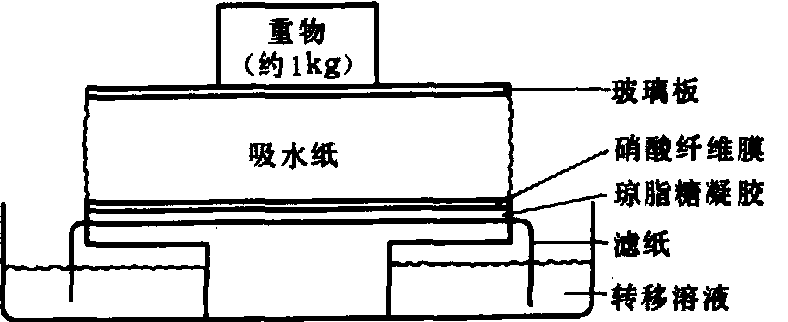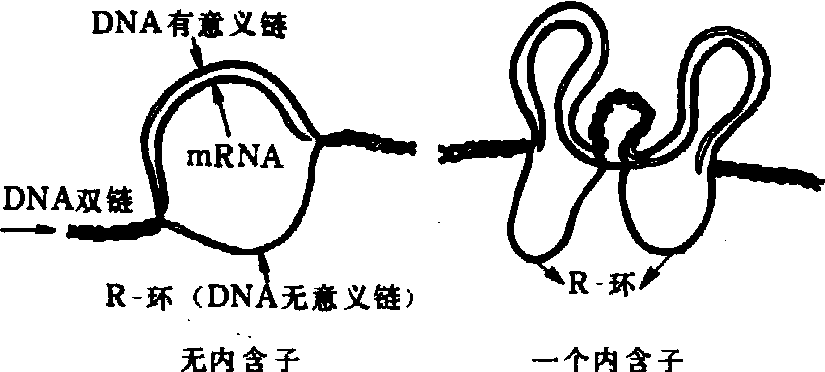核酸分子杂交nucleic acid molecularhybridization
根据异源单链核酸分子间因结构互补发生共价键结合,能形成互补杂合双链,而进行分子遗传学研究的一种技术。双链核酸分子加热至80~100℃时,碱基对之间的氢键断开,形成两条单链,这一过程叫作核酸的变性作用或解链。变性的核酸分子慢慢冷却,互补的碱基对之间又会重新形成双链分子,这一过程叫作核酸的复性作用或退火。核酸分子在pH>10和pH<3的环境中也会变性,当条件适合时又可复性。核酸分子杂交技术是基于核酸变性与复性的原理。
利用核酸杂交技术进行定性或定量分析的最有效方法是将一种核酸单链用同位素或荧光物质标记,制成探针(见核酸分子探针),再与另一种核酸单链杂交。
核酸分子杂交有液相和固相两种方法。液相法的核酸单链分子都在溶液中,通过分子运动进行杂交;固相法是将一种核酸单链固定在不溶性的介质上。另一种核酸单链在溶液中与固定的核酸分子进行杂交。常用的固相介质有硝酸纤维膜、尼龙纤维膜、琼脂糖和聚丙烯酰胺凝胶等。固相核酸分子杂交应用较为广泛。常用的有:
索森印迹法 高分子量DNA用限制性内切酶消化后,经琼脂糖凝胶电泳,使不同大小的DNA片段分离,并直接在胶上变性,然后利用毛细作用(现常用电转移技术),将它们转移到硝酸纤维膜或尼龙纤维膜上,这一过程称为“吸印”。膜上的DNA被固定后与核酸探针(DNA或RNA)杂交。同位素探针通过放射自显影显示结果,荧光探针杂交的结果以荧光显示。这一极为灵敏和有效的核酸杂交技术是以它的发明人索森(E.M.Southern)的姓命名的(图1)。

图 1 索森(Southern)印迹的基本装置
诺森印迹法 类似于索森印迹法。其命名不是创始者的姓名,而是巧用南、北两个方向命名,将 DNA和RNA的分析法区分开来,由索森法引伸出来的名称。它是将RNA分子用琼脂糖或聚丙烯酰胺凝胶电泳分离再吸印到硝酸纤维膜 (或重氮𦭌甲基; DBM纤维膜)上,因RNA是单链分子,所以不用变性,直接与单链核酸分子探针杂交。
染色体原位杂交 也是固相杂交的一种形式。这一技术用来确定某一“目的”DNA顺序在完整染色体上的位置。操作时,将染色体固定在载玻片上,并经过处理除去RNA和蛋白质,使染色体DNA变性,在原来的位置上与核酸探针进行杂交。这一技术首次应用在确定rDNA在核仁组织中心的位置。现已应用于基因的定位。
菌落原位杂交 是原位杂交技术的另一种形式。通常应用于确定带有重组分子的细菌菌落中与探针同源的外源DNA插入片段。细菌菌落首先从培养皿上转移到硝酸纤维膜上,经过细胞裂解,DNA释放,变性和固定后与探针杂交。另一相似的技术是噬菌斑原位杂交,不同的是印迹在硝酸纤维膜上的是噬菌体而不是菌落。这些技术专门用来从基因文库或cDNA文库中筛选与探针同源的重组子。
R-环技术 也是检测核酸杂交的技术。杂交后的分子可以直接在电子显微镜下显示出特定的构象。在双链DNA分子部分变性的情况下,单链的 RNA分子与相应的DNA分子中的一条链互补形成RNA-DNA杂种分子,同时另一条DNA单链向外突出形成环状图象,称之为R-环,该技术由此得名。在电镜图象中,双链区比单链区线条粗,很易分辨。真核生物成熟的mRNA分子与其DNA分子杂交,由于内含子顺序不与mRNA互补而形成R-环,所以可用来研究真核生物基因的结构,根据R-环的数目可确定内含子的数目(图2)。

图 2 R-环图象
核酸分子杂交nucleic acid molecular hybridization
利用异源单链核酸分子间通过结构互补发生共价键结合形成互补杂合双链.进行分子遗传学研究的技术。双链核酸分子的稀盐溶液加热到80~100℃的某个特定温度,由于碱基对之间的氢键断开,形成两条单链,这一过程称核酸的变性或解链。此时如迅速冷却,则两条分开的单链不能复原,仍保持单链状态;如缓慢地冷却,则两条分开的单链又可重新专一性地恢复成双链分子,这一过程称核酸的复性或退火。核酸分子在pH>10和pH<3的环境中也会变性,当条件适合时又可复性。核酸分子杂交技术是基于核酸变性和复性的原理。利用核酸杂交技术进行定性或定量分析的最有效方法是将一种核酸单链用同位素或荧光物质标记,制成探针(见“核酸分子探针”),再与另一种核酸单链杂交,检测与之互补的核苷酸顺序。如果两条单链核苷酸顺序完全互补地相对应,则两条单链可以100%地相结合;如果不是完全互补地相对应,则两条单链可以按相应的百分比相结合或杂合。因此可以利用核酸分子杂交检测不同细菌核酸的核苷酸顺序的相似程度,借以判断各种细菌间的亲缘关系。